The goal of screening tests is to detect some disorders as soon as possible. Some of them are terrible (like anencephaly) so it’s important to diagnose them early so that you can make the best decision.
What are screening tests?
Screening tests are tests that we run on large groups of population to detect some disorders as soon as possible. There are several kinds, and we use them in adults to detect some cancers early, like breast cancer (through mammography) and colon cancer (through occult blood test). Screening tests during pregnancy are used to detect some diseases of the baby as soon as possible.
They are not mandatory. Instead, they will offer them to you so that you decide whether to take them or not.
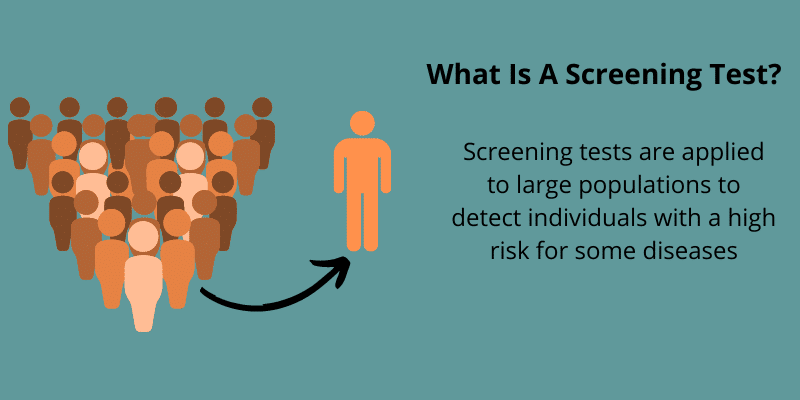
During pregnancy, there are many screening tests available. Some of them are for infectious diseases (like HIV, syphilis) which can be treated. Other tests look for congenital disorders in the baby.
Screening tests, although it may be surprising, are not accurate. They won’t tell you if your baby will have a disease. Instead, it will tell you whether there is a high risk for that disease. Then, the next step is to take a diagnostic test.
Screening Tests vs. Diagnostic Tests
If the screening test says there is a high risk for a disease, then you can have a diagnostic test to confirm it. For example, an amniocentesis or a chorionic villus sampling (CVS). These are diagnostic tests and they can confirm if there is a disease.
So, why don’t we start with them from the beginning? Because they are more aggressive. While screening tests are harmless, diagnostic tests can damage your baby. They can cause a miscarriage (in about 0.5-1% of cases). It’s not a high number, but it can happen.
These are the 2 main diagnostic tests:
· Amniocentesis
It consists of taking a sample from the amniotic fluid that surrounds the fetus. Amniocentesis is performed to high-risk women during the 15th and 20th weeks. High-risk women are those over 35 years or with altered screening tests.
To take the sample, the doctor uses a thin needle that inserts through the skin of your abdomen (they may give you some local anesthetic before) using an ultrasound system to make sure they go inside the amniotic sac.
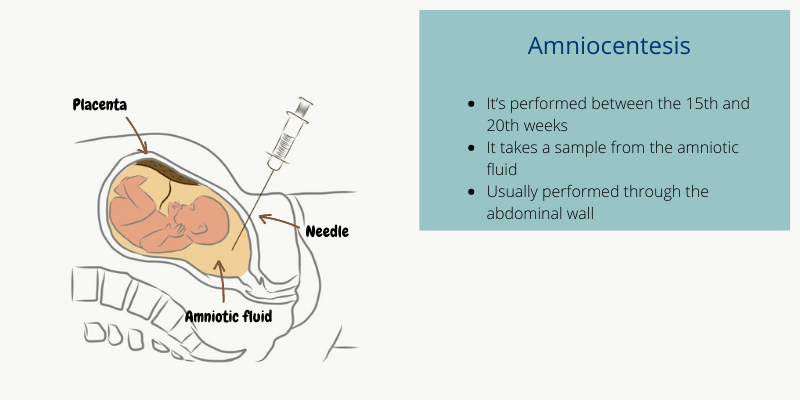
If you have twins, there will be one amniocentesis for each of them. The amniotic samples will contain cells from your baby, which will be analyzed in search of some diseases: chromosopathies (Down, Edwards, and Patau‘s syndromes), spina bifida, etc.
Chorionic villus sampling (CVS)
It consists of taking a sample from your placenta. Your placenta has the same cells as your baby, so it’s like running tests on the fetus.
It is performed earlier than amniocentesis, at around 10th to 13th weeks. At this time, the fetus and the amniotic sac are very small so trying to get a needle inside would be dangerous for the baby, as the needle might hurt them.
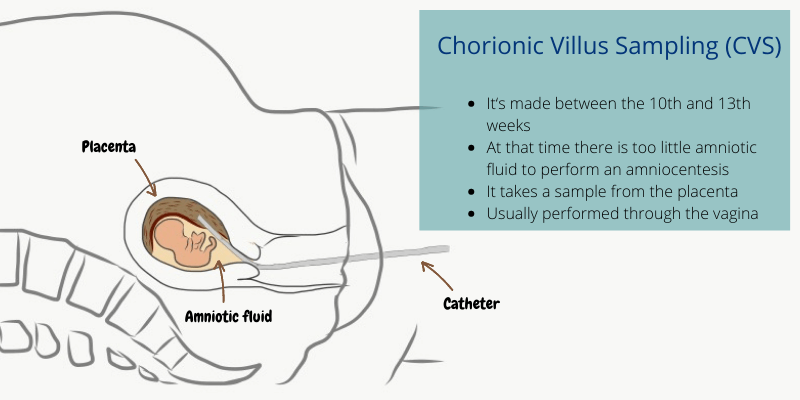
It can detect chromosopathies, but it won’t detect neural tube defects like spina bifida. Amniocentesis, on the other side, can detect both.
CVS is performed through your vagina. Your doctor will place a catheter (a small tube) inside your vagina and through your cervix. Then, guided by an ultrasound, will place the tip of the catheter near the placenta. Once in place, he will take some tissue using a syringe from the other end of the tube. Sometimes, they can perform the CVS through your abdomen (like amniocentesis), but it is less common to do it that way.
You can see the differences between both techniques:
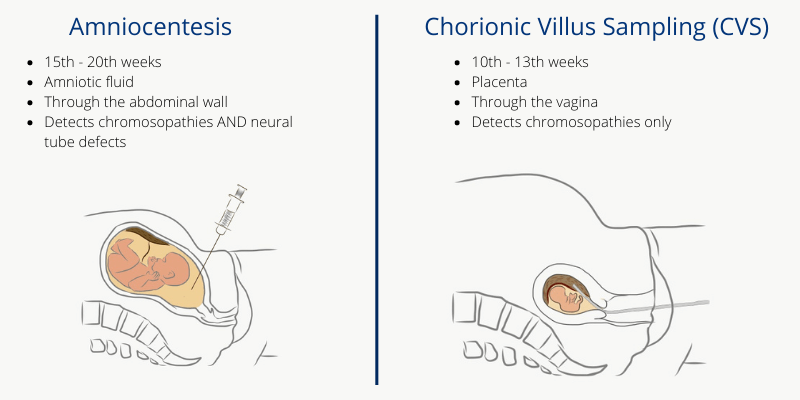
When should I get each of the screening tests?
Let’s see the usual screening tests during pregnancy:
· 7-8th weeks – Sickle cell & thalassemia
A blood test can detect if you are a carrier for these diseases. If you are a carrier that doesn’t mean you are affected, but that you could pass it on to your baby. The only way your baby can be affected is if the father is also a carrier. So if you test positive (+), your partner may be screened too.
· 8-12th weeks – Infectious diseases: HIV, hepatitis B & syphilis
The doctor will test you for these three diseases. It’s very important to detect them and treat them early, because that way, the transmission is way lower.
If you are infected with HIV, the right treatment during pregnancy can lower the risk of transmission to 1%! (only 1 in 100 newborns will acquire HIV).
If you have hepatitis B, there is a treatment for your baby right after they are born. It is the hepatitis B immune globulin and hepatitis B vaccine.
· Any moment of pregnancy – Eye check-ups if you are diabetic
If you are diabetic, you can get your eyes checked. Why? To exclude diabetic retinopathy. That is a complication of diabetes that can happen to anyone but is even more frequent during pregnancy.
· 10-14th week – Combined test: U.S. + blood test
It consists of a blood test and an ultrasound. The blood test detects two markers: β-HCG and PAPP-A.
The ultrasound measures the nuchal translucency. To put it simply, it is the size of the fat behind the baby’s neck. It might seem unimportant, but it is a marker for Down syndrome. Also, it will date your baby more accurately (and the probable date of birth, too) and can detect multiple pregnancies, like twins.
The doctor will put together all these parameters and give you a result: increased risk or not at increased risk. If you are at increased risk, that means your baby has > 1/300 chances of suffering some of the three main trisomies: Down, Patau, and Edwards syndromes.
On the other hand, if you are not at increased risk, then your baby has < 1/300 chances, which is considered a “normal” risk.
If you are at increased risk, you can choose to take a diagnostic test like amniocentesis or chorionic villus sampling, depending on which week you are at.
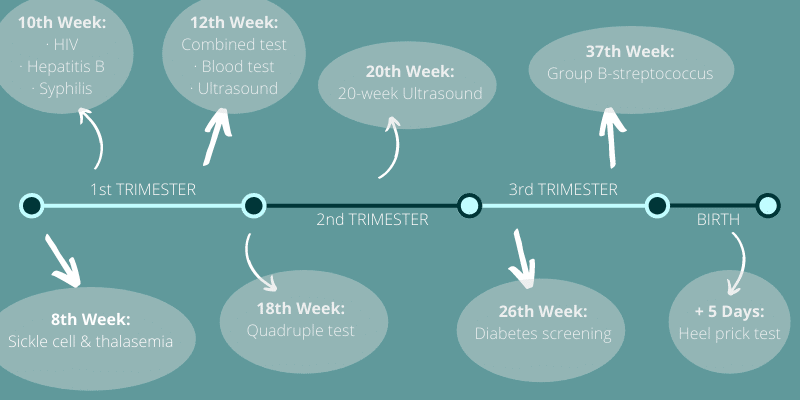
· < 20th week – Quadruple test
You should only get the quadruple test if the combined test could not be performed correctly. For example, sometimes the ultrasound can’t measure the nuchal translucency because of the baby’s position.
If your combined test was ok, then you shouldn’t take this one, because it won’t add any new results. In fact, this one is more limited because it only detects Down syndrome.
They call it the quadruple test because it measures four markers in your blood:
- alpha-fetoprotein (AFP)
- human chorionic gonadotropin (β-HCG
- unconjugated estriol (uE3)
- inhibin A
Putting together the four values, your doctor can estimate the risk for Down syndrome. Again, this is not a definitive test. You have to take a diagnostic test if the risk is high.
· 20th week: “20th-week ultrasound”
This ultrasound searches for 11 conditions in your baby, relating their heart, bones, and brain:
- Anencephaly
- Open spina bifida
- Cleft lip
- Diaphragmatic hernia
- Gastroschisis
- Exomphalos
- Cardiac malformations
- Bilateral renal agenesia
- Lethal skeletal dysplasia
- Edward‘s syndrome
- Patau‘s syndrome
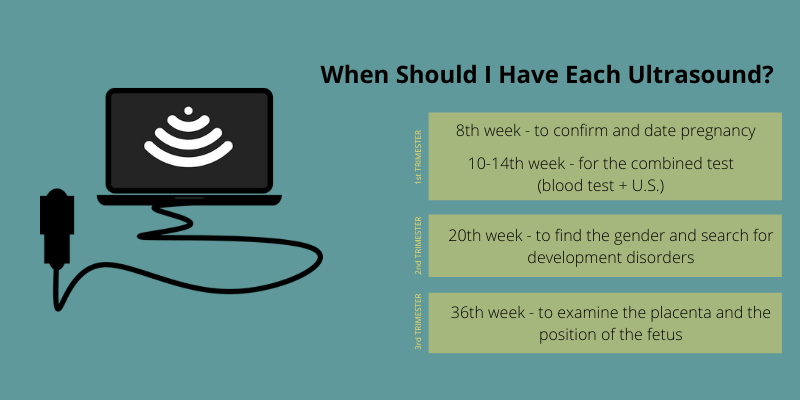
· 24-28th week – Diabetes screening
They measure the levels of glucose in your blood, to exclude gestational diabetes, which is diabetes caused temporarily by your pregnancy.
Remember this is different from the eye check-up for diabetic people, which is done to people that already are diabetic before pregnancy.
· 36th week- Third-trimester ultrasound
At around this time, the doctor may perform an ultrasound to examine the placenta and the position of the fetus (you want your fetus to have their head pointing downwards).
· 35-37 weeks – Group B Streptococcus
Group B Streptococcus is a bacteria that can be found in about 20% of women, in their lower genital tract. It usually doesn’t cause any symptoms or problems, but if the baby gets infected, there is a risk for chorioamnionitis, pneumonia, or meningitis in the baby.
If you test positive, you must take antibiotics. That way you’ll avoid infecting your baby.
· 3 days after birth – Physical examination
When your baby is 3 days old, the doctor will perform a physical examination, checking their eyes, hearing, heart, and hips.
If it’s a boy, they will check his testicles too.
· 5 days after birth – Blood spot test
It‘s also called the heel prick test. It consists of a puncture on the baby’s heel to then analyze the blood drop that comes out.
After the analysis, 9 conditions are screened: sickle cell disease, cystic fibrosis, hypothyroidism and some metabolic disorders. These conditions are rare but serious, so it’s better to detect them early. If you treat them correctly from the beginning, the prognosis can improve dramatically.
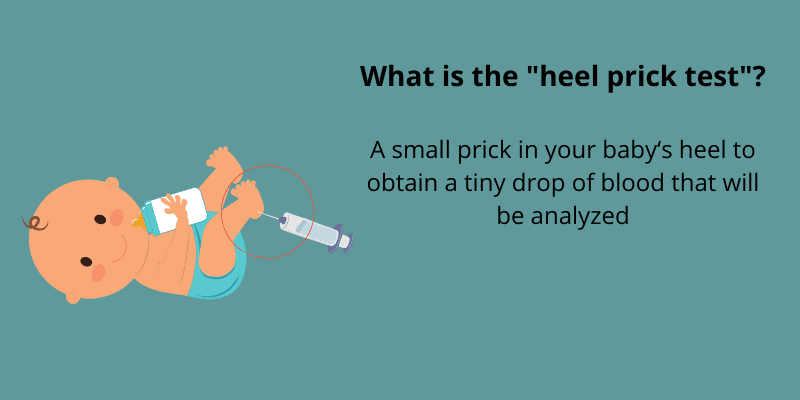
What are the risks of Screening Tests?
Screening tests are relatively safe. There are no physical risks to them. The only risk, if you want to consider it this way, is the risk of having to make a difficult decision. But it’s usually better to have all the information from the beginning, and then decide what to do.
Anyway, remember that you don’t have to take the screening test if you don’t want to.
Leave a Reply